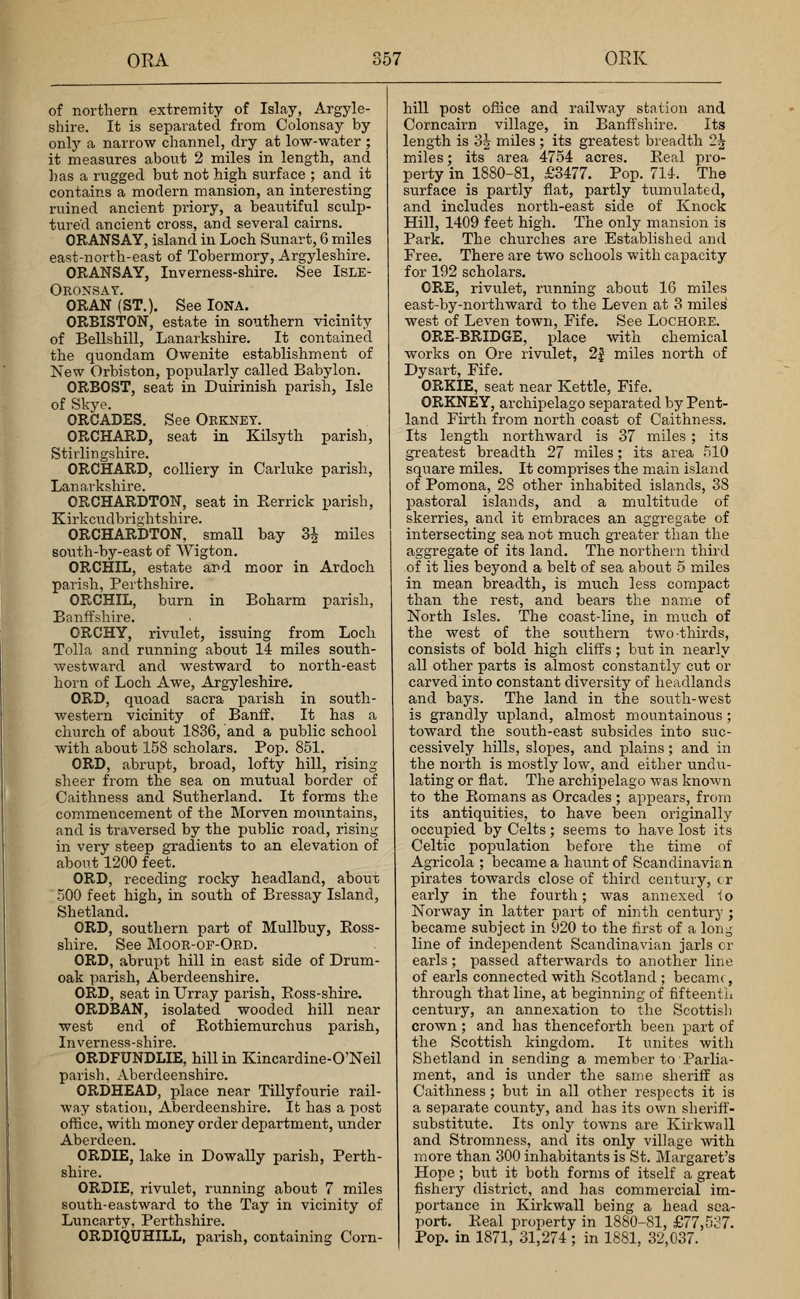ORANSAY, island in Loch Sunart, 6 miles east-north-east of Tobermory, Argyleshire.
ORANSAY, Inverness-shire.
ORAN (ST.).
ORBISTON, estate in southern vicinity of Bellshill, Lanarkshire. It contained the quondam Owenite establishment of New Orbiston, popularly called Babylon.
ORBOST, seat in Duirinish parish, Isle of Skye.
ORCADES.
ORCHARD, seat in Kilsyth parish, Stirlingshire.
ORCHARD, colliery in Carluke parish, Lanarkshire.
ORCHARDTON, seat in Eerrick parish, Kirkcudbrightshire.
ORCHARDTON, small bay 3 miles south-by-east of Wigton.
ORCHIL, estate and moor in Ardoch parish, Perthshire.
ORCHIL, burn in Boharm parish, Banffshire.
ORCHY, rivulet, issuing from Loch Tolla and running about 14 miles south-westward and westward to north-east horn of Loch Awe, Argyleshire.
ORD, quoad sacra parish in south-western vicinity of Banff. It has a church of about 1836, and a public school with about 158 scholars. Pop. 851.
ORD, abrupt, broad, lofty hill, rising sheer from the sea on mutual border of Caithness and Sutherland. It forms the commencement of the Morven mountains, and is traversed by the public road, rising in very steep gradients to an elevation of about 1200 feet.
ORD, receding rocky headland, about 500 feet high, in south of Bressay Island, Shetland.
ORD, southern part of Mullbuy, Koss-shire.
ORD, abrupt hill in east side of Drum-oak parish, Aberdeenshire.
ORD, seat in Urray parish, Ross-shire.
ORDBAN, isolated wooded hill near west end of Eothiemurchus parish, Inverness-shire.
ORDFUNDLIE, hill in Kincardine-O'Neil parish, Aberdeenshire.
ORDHEAD, place near Tillyfourie rail-way station, Aberdeenshire. It has a post office, with money order department, under Aberdeen.
ORDIE, lake in Dowally parish, Perthshire.
ORDIE, rivulet, running about 7 miles south-eastward to the Tay in vicinity of Luncarty, Perthshire.
ORDIQUHILL, parish, containing Cornhill post office and railway station and Corncairn village, in Banffsliire. Its length is 3% miles ; its greatest breadth 2 miles; its area 4754 acres. Real property in 1880-81, 3477. Pop. 714. The surface is partly flat, partly tumulated, and includes north-east side of Knock Hill, 1409 feet high. The only mansion is Park. The churches are Established and Free. There are two schools with capacity for 192 scholars.
ORE, rivulet, running about 16 miles east-by-northward to the Leven at 3 miles' west of Leven town, Fife.
ORE-BRIDGE, place with chemical works on Ore rivulet, 2J miles north of Dysart, Fife.
ORKIE, seat near Kettle, Fife.
ORKNEY, archipelago separated by Pentland Firth from north coast of Caithness. Its length northward is 37 miles ; its greatest breadth 27 miles; its area 510 square miles. It comprises the main island of Pomona, 28 other inhabited islands, 38 pastoral islands, and a multitude of skerries, and it embraces an aggregate of intersecting sea not much greater than the aggregate of its land. The northern third of it lies beyond a belt of sea about 5 miles in mean breadth, is much less compact than the rest, and bears the name of North Isles. The coast-line, in much of the west of the southern two-thirds, consists of bold high cliffs ; but in nearly all other parts is almost constantly cut or carved into constant diversity of headlands and bays. The land in the south-west is grandly upland, almost mountainous ; toward the south-east subsides into successively hills, slopes, and plains ; and in the north is mostly low, and either undulating or flat. The archipelago was known to the Romans as Orcades ; appears, from its antiquities, to have been originally occupied by Celts ; seems to have lost its Celtic population before the time of Agricola ; became a haunt of Scandinavian pirates towards close of third century, c r early in the fourth; was annexed io Norway in latter part of ninth century ; became subject in 920 to the first of a Ion.; line of independent Scandinavian jarls cr earls ; passed afterwards to another line of earls connected with Scotland ; becarru , through that line, at beginning of fifteenth century, an annexation to the Scottish crown ; and has thenceforth been part of the Scottish kingdom. It unites with Shetland in sending a member to Parliament, and is under the same sheriff as Caithness ; but in all other respects it is a separate county, and has its own sheriff-substitute. Its only towns are Kirkwnll and Stromness, and its only village with more than 300 inhabitants is St. Margaret's Hope ; but it both forms of itself a great fishery district, and has commercial im-

